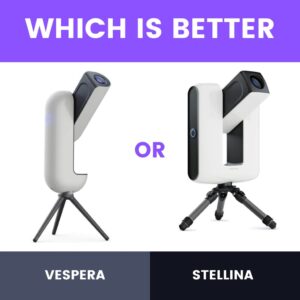This site contains affiliate links to products. I may receive a commission for purchases made through these links.
Celestron is a well-known brand in the consumer astronomy space. The company’s popularity is due to the high quality of its well-built products and a broad range of telescopes for different pockets and needs. Whether you’re on a budget and/or want to see the planets, there’s a Celestron telescope that meets your needs.
With many telescope options, you may find it hard to choose a model that offers the best value for your budget.
To help you find the best Celestron telescope to see planets, we have reviewed 10 of the top telescopes by the Celestron brand. We also examined the factors you should consider when choosing a Celestron telescope for planet observation.
1. Celestron NexStar Evolution 8 HD – Best medium-range telescope for experienced night sky observers
The Celestron NexStar Evolution 8 HD is a computerized Schmidt-Cassegrain telescope. This design has an aperture size of 8 inches and a focal length of 80 inches. Thus, its focal ratio is f/10.
The telescope has an in-built WiFi to connect the scope to your smart devices via the Celestron SkyPortal app. The Celestron NexStar Evolution 8 HD is also equipped with StarSense AutoAlign, which makes the star alignment process automatic.
It’s also fitted with a goto mount that makes tracking night sky objects smooth. The mount also provides a very steady base for solar system observations.
Some of the things we like about this telescope include its internal battery, easy setup, lack of visual defects like chromatic or spherical aberration, high-quality accessories and software, and the ability to accommodate all kinds of cameras.
All these and more make the Nexstar Evolution 8 an excellent telescope for viewing planets.
One downside of this telescope is that it’s not the most portable Celestron telescope. At 18.5kg, you must make serious considerations if you plan to move it from your place.
You may also like: Are Celestron NexStar Telescopes Good? (Breakdown of all Models).
2. Celestron CPC Deluxe 1100 HD Computerized Telescope – Best premium option
One of the most premium offerings from Celestron, the CPC Deluxe 1100 HD Computerized Telescope is a juggernaut of a telescope. It delivers awesome optical quality with little to no aberrations.
It has an enormous aperture of 11 inches and a significant focal length of 110 inches. These specifications give it a minimum and maximum useful magnification of 40X and 660X, respectively.
Despite having an altazimuth mount, the 1100HD performs incredibly well for astrography. Adding the HD Pro Wedge transforms the telescope into a complete astrography setup.
A telescope with a large aperture size is heavy, and the dual fork arm mount provided with the 1100HD can handle this weight. The mount is also equipped with GPS and SkyAlign, thus providing a solid base for precise deep-sky object tracking.
The 1100HD also comes with a top-of-the-range 23mm Plössl eyepiece from its Luminos set. This eyepiece gives you a magnification power of 122X.
When paired with the long focal length and consequent narrower fields of view, any skywatcher can enjoy a clean and crisp view of the planets.
Read the full review here: Celestron CPC 1100 Telescope Review
3. Celestron NexStar 8 SE Computerized Telescope – Best value computerized scope for beginners
The Nexstar 8 SE Computerized Telescope provides tremendous value for money with its big mirror. It has the biggest aperture in Celestron’s Nexstar telescope series. The 8 SE is not only one of Celestron’s best but one of the best telescopes, particularly at its price point.
It boasts a big aperture of 8 inches, which gives it a top-notch light-gathering ability. Its focal length is 80 inches, with a focal ratio of f/10.
The Nexstar 8 SE also has all the notable computerized features, including a goto mount, SkyAlign, a database of night sky objects, and hand control.
With its light-gathering ability, you can observe most planets and their details, including the cloud bands of Jupiter and Cassini’s Division separating Saturn’s A and B rings. You may even be able to spot Pluto if you have a very clear night sky.
One advantage of the Nexstar 8 SE – and all telescopes in the Nexstar series – is its portability. It’s easy to dismantle into lightweight components. This makes it less difficult to set up and transport.
You may also like: Celestron NexStar 8SE Review (Planetary Telescope).
4. Celestron NexStar 6SE Computerized Telescope – Best balance between aperture size and value
The 6 SE is the next in Celestron’s Nexstar series and perhaps the most popular of the bunch. Its aperture size is approximately 6 inches (5.91 inches exactly), and its focal length is 59.1 inches.
Its computerized features are the same as the 8 inches version. The only difference is the aperture size.
It has the highest useful magnification of 354X. It also comes with a Plossl eyepiece with a focal length of 25 mm, which translates to a magnification power of 60X.
Its adequate aperture size and narrow field of view make it a very capable planetary telescope. Using this telescope in ideal conditions, you should see Jupiter, Saturn, and Mars in precise detail.
The Celestron Nexstar 6 SE has an incredible balance of features and aperture size, which makes it ideal for a beginner skywatcher and intermediates alike.
Read the full review here: Nexstar 6SE Telescope Review
5. Celestron NexStar 5SE Computerized Telescope – Powerful and affordable option for stargazers
The third scope in Celestron’s Nexstar “orange tube” series is the 5 SE. The 5 SE has the same tripod stand as the 6 and 8 inches, although it’s perched on a smaller mount than these two.
Its design is also the same Schmidt-Cassegrain setup as the 6 and 8 inches versions. The Celestron NexStar 5 SE Computerized Telescope has an aperture size of 4.92 inches and a focal length of 49 inches.
So, the 5 SE has a focal ratio of f/10, which makes it a viable telescope to see planets.
The highest useful magnification of the 5 SE is 295X. The 25mm eyepiece that comes with it provides a magnification power of 50X. You should be able to see as far as Jupiter and Saturn, including observing clear details about these night sky objects.
They equally come equipped with the same Goto features that make tracking easy. A common complaint about the Nexstar series is that they are not power efficient.
Read the full review here: Celestron NexStar 5SE Telescope
6. Celestron NexStar 4SE Computerized Telescope – Compact and portable option
The Nexstar 4 SE is the odd one out of the four versions. While the others have a Schmidt-Cassegrain design, the 4 SE has a Maksutov-Cassegrain (MAK) design.
Although the Maksutov-Cassegrain is similar to the Schmidt-Cassegrain design, there are some subtle differences.
The chief difference is that the MAK design allows the 4 SE to draw more light than it could have if it had the Schmidt-Cassegrain design.
Additionally, while the others have an f/10 focal ratio, the 4 SE has a focal ratio of f/13. This specification means the Celestron Nexstar 4 SE computerized telescope has a very narrow field of view and is more useful for planetary viewing. Expect to see the rings on Saturn and Jupiter’s cloud bands.
You may also like: Celestron NexStar 4SE Review
7. Celestron Astro Fi 130mm Newtonian Reflector Telescope – Best for both deep sky objects and planets

The Astro Fi is one of the most recent computerized offerings from Celestron. It draws heavily from the old SLT design. The Celestron Astro Fi 130mm Newtonian Reflector Telescope comes with an in-built WiFi system.
With this system, you can control the telescope from your mobile phone via the SkyPortal app. This is a better option than using an LCD control that is still popular with other computerized telescopes.
Other computerized features of the Astro Fi include SkyAlign, a goto alt-azimuth mount, and Starry Night software. It also features a smartphone adapter for taking pictures on your mobile phone.
The Astro Fi has an aperture size of 5.19 inches and a focal length of 25.59 inches for a focal ratio of f/5. Some of the celestial objects you can view include Jupiter’s Great red spot, Saturn’s rings, and other deep sky objects like the Hercules Globular Cluster.
Some of the things we like about this scope are that it’s easy to set up, portable and lightweight, easy to use, and it has high-quality optics for the aperture size.
Read also:
8. Celestron Advanced VX 6” SCT Telescope – Fantastic mid-range option for planetary imaging
The Advanced VX 6 inches scope is a superb mid-level telescope equipped with a computerized German equatorial mount. This feature makes them great for planetary imaging.
It comes with a 6 inches aperture and focal length of 59 inches for an f/10 focal ratio, which makes it suitable for viewing planets. It has a maximum useful magnification of 354X.
The Celestron Advanced VX 6” SCT telescope’s goto capabilities allow for easy tracking of celestial objects. Its mount is fitted with steel tripod legs that provide stability when observing planets.
The mount also has ports to connect with other Celestron accessories, such as StarSense AutoAlign and the SkyPortal WiFi adapter.
Within the solar system, you should be able to see good details about most of the planets. The level of detail you see will vary from planet to planet and on seeing conditions.
You may also like: Celestron SkyPortal WiFi Module (Setup & Review)
9. Celestron FirstScope 76mm Reflector Telescope – Best telescope for children
The Celestron FirstScope 76mm Reflector Telescope is the cheapest on this list. And it is there because it’s the perfect telescope to introduce astronomy to kids or a complete novice.
It is perfect for kids because it comes preassembled. So, there’s no complicated setup other than fixing the finderscope to the telescope.
Despite its small aperture size of 3 inches and a focal length of 12 inches, the FirstScope still offers a workable optical quality, especially at its price point.
The design is compact and good for camping with the kids. The downside, though, is that it has a short base. You’ll need an elevated position to use the telescope comfortably.
You may also like: The Best Telescope For Kids To Spark an Interest in Astronomy
10. Celestron 114LCM Computerized Newtonian Telescope – Lowest priced Celestron goto telescope for beginners

Rounding off our list is the Celestron 114LCM Computerized Newtonian Telescope with an aperture size of 4.5 inches and a focal length of 39 inches. It has a narrow field of view, which favors planetary viewing over observing deep sky objects.
As with other Celestron computerized telescopes, it comes with SkyAlign, which, when done correctly, improves the accuracy of your observations. It can also quickly help you to locate one of the thousands of celestial objects in its database.
The 114LCM has a lightweight mount, making it easy to transport and set up.
You may also like: Is Celestron a Good Telescope Brand?
Factors to consider when choosing a Celestron telescope for planet observation
Before choosing any telescope for any purpose, you need a set of guiding rubrics, so you don’t select the wrong one. When choosing a Celestron telescope for planetary observation, you should consider the following:
Aperture size
A telescope’s aperture size is its most important specification. It determines what you can see and the resolution of what you see. For example, you cannot see Pluto with a telescope that has an aperture size of less than 10 inches.
A 10-inch telescope will allow you to see the Galilean moons when observing Jupiter, and a telescope of smaller aperture size, say 6-8 inches, will show you Jupiter no doubt, but you may not see all the finer details of the planet.
If you’re getting into astrography, only a telescope with an aperture size of at least 6 inches will produce decent pictures. Hence, aperture size must be on top of the list of things you consider before buying a telescope.
All other things being equal – clear night sky, steady seeing, etc. – a bigger aperture Celestron telescope would improve the quality of your stargazing.
In technical terms, aperture size measures the diameter of the primary optical material collecting light in the telescope. The aperture size of any telescope is given in inches or millimeters.
In reflector telescopes, it’s the primary mirror’s diameter. In a refractor telescope, it is a measure of the objective lens. A bigger aperture size of the same telescope design will most likely cost and weigh more than telescopes of smaller aperture sizes.
You may also like: What is a good aperture for a telescope?
Magnification power and focal length
The magnification power is a function of the focal length of your telescope and the focal length of the eyepiece (ocular) that you’re using for planetary observation.
The formula for calculating magnification power is:
The focal length of the telescope (in millimeters) / the focal length of the eyepiece (in millimeters).
If you use a 5mm eyepiece with a telescope of 1,000mm focal length, you’ll have a magnification power of:
1000/5=200X
A 10mm eyepiece will yield a power of:
1000/10=100X
So, it’s in your hands to increase the power of your telescope depending on what you want to observe.
Knowing how to alter the magnification power of your telescope gives you flexibility and the ability to respond to different seeing conditions during your planetary observations.
Additionally, each telescope has what is known as the highest and lowest useful magnification or the maximum and minimum usable power. Think of this value as the practical boundaries to use your telescope.
The highest useful magnification is typically 50-60X of the telescope’s aperture size under the best seeing conditions. So a telescope with an 8-inch aperture has a theoretical maximum power of 400-480X. If you attempt to view deep sky objects beyond this magnification power, they’ll appear dim and with reduced sharpness.
On the other hand, the minimum useful magnification is 3-4X of the telescope’s aperture size.
Lastly, a telescope with high magnification and a narrow field of view is better for viewing planets and overseeing the moon.
Portability
In this context, portability refers to how easy it is to move and/or travel with your telescope. You may have to travel regularly because you’re chasing clear skies and good views.
How far you travel, and the mode of transportation would determine what kind of telescope you can take with you.
If you’re taking a flight, your telescope has to be in your hand luggage. And that restricts what size and weight of telescope you can carry.
You also do not want a portable telescope that is bad at observing solar system objects.
If you travel a lot, you definitely want a portable “grab and go” telescope with substantial quality. Even if you don’t travel regularly, you want a telescope that you can dismantle and easily set up.
Budget
You don’t necessarily have to break the bank to get a good quality Celestron telescope. However, below a price point, the optical quality you get is probably worthless to your planetary viewing.
That said, it’s good to know how much you’re willing to spend. This way, it’s easier to research and find the telescope with the best value on this budget.
Ultimately, you want a budget that can get you a telescope with good optical quality and sound mechanical quality. Mechanical quality refers to things like how stable the mount and tripod are.
As a loose guideline, draw up a budget for a telescope with at least 3.5 inches and 5 inches aperture size for a refractor telescope and reflector telescope, respectively.
You may also like: Refractor vs Reflector Telescope (What Is The Difference)
Personal preferences and solar system skill level
Ultimately, the Celestron telescope you choose will depend on what you want to use the telescope for and your skill level.
We recommend that beginner astronomers get more affordable telescopes when starting. And as you get more familiar with astronomy and the whole night sky observation business, you can upgrade your telescope.
In this case, where planetary viewing is the primary consideration, you want a telescope with a long focal ratio and a decent aperture size. If the wide view of stars gets your astronomy sense tingling, then a telescope with a short focal length will suffice.
Also, if you plan to mount a camera to your telescope, buy one with an equatorial mount. Telescopes with equatorial mounts are preferable for the longer exposure requirements of astrophotography.
Takeaway: Enjoy planetary viewing at its best with Celestron telescopes
The Celestron NexStar Evolution 8 HD and the CPC Deluxe 1100 HD Computerized Telescope are incredible mid-range and premium telescopes you can use to view planets.
You can’t also go wrong buying any of the Nexstar series. They offer the perfect balance between aperture size and price.
Before you choose one of the scopes discussed in this guide, consider the aperture size of the telescope, your budget, magnification power, portability, and your personal preferences and skill level.
Read also:












